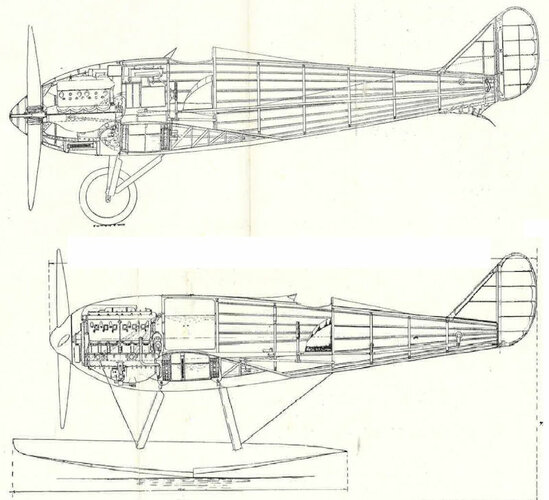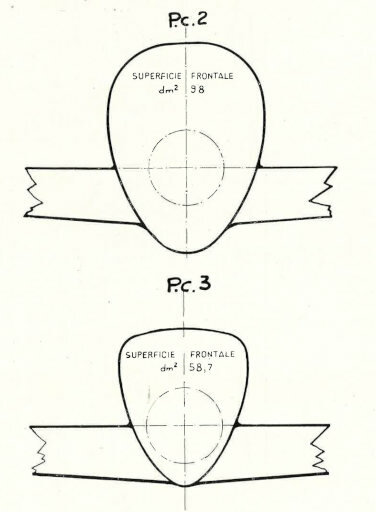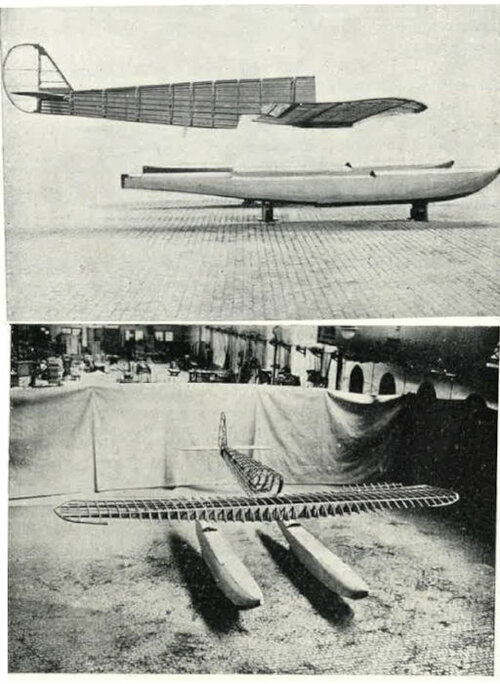You are using an out of date browser. It may not display this or other websites correctly.
You should upgrade or use an alternative browser.
You should upgrade or use an alternative browser.
Pegna and Piaggio - Italian floatplane / seaplane projects - Schneider Trophy
- Thread starter Maveric
- Start date
this sitehttp://alain.vassel.pagesperso-orange.fr/piaggio.htm has a number of pegna's early sea plane designs but they are not numbered
- Joined
- 26 May 2006
- Messages
- 33,572
- Reaction score
- 13,701
shaba said:this sitehttp://alain.vassel.pagesperso-orange.fr/piaggio.htm has a number of pegna's early sea plane designs but they are not numbered
From the site you mentioned before Shaba;
and also from that PDF report;
http://www.avia-it.com/act/profili_daerei/aerei_di_ieri_e_di_oggi/Aerei_ieri_e_oggi_Avia_Files/PA_aerei_ieri_AVIA_files_agg_genn_07/1_Idrovolanti_da_corsa/Idee_sugli_idrovolanti_da_corsa.pdf
Attachments
- Joined
- 26 May 2006
- Messages
- 33,572
- Reaction score
- 13,701
Hi,
here is anther early Pegna and Piaggio aircraft and projects;
http://www.collezionarecartoline.it/fotoaltre.php?foto=finalmarina298pag836.jpg&id_comune=955&id=1866
here is anther early Pegna and Piaggio aircraft and projects;
http://www.collezionarecartoline.it/fotoaltre.php?foto=finalmarina298pag836.jpg&id_comune=955&id=1866
Attachments
- Joined
- 26 May 2006
- Messages
- 33,572
- Reaction score
- 13,701
Kdmoo said:Here is a photo of the Pegna-Rondine.
hesham- Was the Pegna-Bonmartini-Cerrone a project only or was it built? Thanks.
Hi Kdmoo;
frankly,I don't know,but could be any Italian member knows.
- Joined
- 26 May 2006
- Messages
- 33,572
- Reaction score
- 13,701
- Joined
- 3 June 2006
- Messages
- 2,964
- Reaction score
- 3,235
Hi folks
here some Italian high-speed floatplane / seaplane projects from Pegna and Piaggio, featured in the article "Nie geflogen - trotzdem berühmt, Signor Pegnas Superrenner >>Pinochino<<" from Ferdinand C. W. Käsmann, published in the German annual book "Flieger Kalender 2007 / 2008", pages 116 to 126.
Dear mods and dear members, please feel free to move or mention these attachments in other topics.
here some Italian high-speed floatplane / seaplane projects from Pegna and Piaggio, featured in the article "Nie geflogen - trotzdem berühmt, Signor Pegnas Superrenner >>Pinochino<<" from Ferdinand C. W. Käsmann, published in the German annual book "Flieger Kalender 2007 / 2008", pages 116 to 126.
Dear mods and dear members, please feel free to move or mention these attachments in other topics.
Attachments
-
 Italian_hydrofoil_seaplanes_FliegerKalender_2007_2008_page123.png216.5 KB · Views: 146
Italian_hydrofoil_seaplanes_FliegerKalender_2007_2008_page123.png216.5 KB · Views: 146 -
 Pegna_Piaggio_P7_1930_FliegerKalender_2007_2008_page124.png151.7 KB · Views: 152
Pegna_Piaggio_P7_1930_FliegerKalender_2007_2008_page124.png151.7 KB · Views: 152 -
 Pegna_Piaggio_P7_Cutaway_1930_FliegerKalender_2007_2008_page125.png144.3 KB · Views: 176
Pegna_Piaggio_P7_Cutaway_1930_FliegerKalender_2007_2008_page125.png144.3 KB · Views: 176 -
 Pegna_Piaggio_P7_2nd_type_1930_FliegerKalender_2007_2008_page125.png144.3 KB · Views: 163
Pegna_Piaggio_P7_2nd_type_1930_FliegerKalender_2007_2008_page125.png144.3 KB · Views: 163 -
 Pegna_Pc_6_1928_FliegerKalender_2007_2008_page122.png201.3 KB · Views: 138
Pegna_Pc_6_1928_FliegerKalender_2007_2008_page122.png201.3 KB · Views: 138 -
 Pegna_Pc_4_1928_FliegerKalender_2007_2008_page121.png116.3 KB · Views: 186
Pegna_Pc_4_1928_FliegerKalender_2007_2008_page121.png116.3 KB · Views: 186 -
 Pegna_Pc_3__Piaggio_P4_1923_FliegerKalender_2007_2008_page119.png182.7 KB · Views: 201
Pegna_Pc_3__Piaggio_P4_1923_FliegerKalender_2007_2008_page119.png182.7 KB · Views: 201 -
 Pegna_Pc_2__Piaggio_P4_1923_FliegerKalender_2007_2008_page118.png192.1 KB · Views: 224
Pegna_Pc_2__Piaggio_P4_1923_FliegerKalender_2007_2008_page118.png192.1 KB · Views: 224 -
 Pegna_Piaggio_P2_1923_FliegerKalender_2007_2008_page117.png290.9 KB · Views: 242
Pegna_Piaggio_P2_1923_FliegerKalender_2007_2008_page117.png290.9 KB · Views: 242 -
 Pegna_Pc_1_1921_FliegerKalender_2007_2008_page116.png252.4 KB · Views: 231
Pegna_Pc_1_1921_FliegerKalender_2007_2008_page116.png252.4 KB · Views: 231
roadrunner2
ACCESS: Restricted
- Joined
- 26 July 2007
- Messages
- 39
- Reaction score
- 12
W
Wingknut
Guest
Maybe this should be in 'Patent Pending' (if so, apologies) - anyway:
'Fin system for hydroaeroplanes and/or water aircraft' (US 1776700 A).
Publication date: 23rd September 1930; Filing date: 12th April 1929.
Inventors: Giovanni Pegna.
Cheers, 'Wingknut'.
'Fin system for hydroaeroplanes and/or water aircraft' (US 1776700 A).
Publication date: 23rd September 1930; Filing date: 12th April 1929.
Inventors: Giovanni Pegna.
Cheers, 'Wingknut'.
Attachments
Tonton-42
ACCESS: Secret
- Joined
- 10 May 2014
- Messages
- 311
- Reaction score
- 556
roadrunner2 said:The PC-7 was one of the most fabulous seaplane ever build.
I do a 1/48 model .
Hello !
Do you know that ? This is from an old Modèle Réduit d'Avion number 591 (the famous MRA !) and Mister Vassel is an exceptionnal modelist !
Regards.
Tonton
Attachments
blackkite
Don't laugh, don't cry, don't even curse, but.....
- Joined
- 31 May 2007
- Messages
- 8,597
- Reaction score
- 6,844
Hi PC-7!
http://doz.jp/wordpress/blog/category/piaggio-p-c-7/
http://alain.vassel.pagesperso-orange.fr/piaggio.htm
http://doz.jp/wordpress/blog/category/piaggio-p-c-7/
http://alain.vassel.pagesperso-orange.fr/piaggio.htm
Attachments
roadrunner2
ACCESS: Restricted
- Joined
- 26 July 2007
- Messages
- 39
- Reaction score
- 12
Hello,
all you can want is here: http://giadel.webnode.it/
photos: http://giadel.webnode.it/foto/
plans and drawing: http://giadel.webnode.it/menu/disegni/
all you can want is here: http://giadel.webnode.it/
photos: http://giadel.webnode.it/foto/
plans and drawing: http://giadel.webnode.it/menu/disegni/
- Joined
- 19 October 2012
- Messages
- 1,953
- Reaction score
- 1,842
English translation by NACA of Pegna's paper describing the PC-7 development
http://ntrs.nasa.gov/archive/nasa/casi.ntrs.nasa.gov/19930094725.pdf
and the original in Italian
http://www.avia-it.com/act/profili_daerei/aerei_di_ieri_e_di_oggi/Aerei_ieri_e_oggi_Avia_Files/PA_aerei_ieri_AVIA_files_agg_genn_07/1_Idrovolanti_da_corsa/Idee_sugli_idrovolanti_da_corsa.pdf
http://ntrs.nasa.gov/archive/nasa/casi.ntrs.nasa.gov/19930094725.pdf
and the original in Italian
http://www.avia-it.com/act/profili_daerei/aerei_di_ieri_e_di_oggi/Aerei_ieri_e_oggi_Avia_Files/PA_aerei_ieri_AVIA_files_agg_genn_07/1_Idrovolanti_da_corsa/Idee_sugli_idrovolanti_da_corsa.pdf
- Joined
- 26 May 2006
- Messages
- 33,572
- Reaction score
- 13,701
- Joined
- 19 October 2012
- Messages
- 1,953
- Reaction score
- 1,842
The text says propulsion a reazione, which translates, roughly, as jet propulsion. What kind I do not know, this is a paper from 1934 so many years before any workable jet propulsion system had been run
- Joined
- 19 October 2012
- Messages
- 1,953
- Reaction score
- 1,842
Yes it is very unusual. There is an air intake behind the cockpit and exhaust by the tail so it has to be some form of jet rather than a rocket but 1934 is very, very early for such a concept.
- Joined
- 19 October 2012
- Messages
- 1,953
- Reaction score
- 1,842
From Wikipedia, perhaps someone can provide more details
In 1931, Italian engineer Secondo Campini submitted a report on the potential of jet propulsion to the Regia Aeronautica, and demonstrated a jet-powered boat in Venice the following year. In 1934, the Regia Aeronautica granted approval for the development of a jet aircraft to demonstrate the principle.
As designed by Campini, the aircraft did not have a jet engine in the sense that we know them today. Rather, a conventional 900 hp (670 kW) Isotta Fraschini L.121 RC.40 12-cylinder liquid-cooled piston engine was used to drive a three-stage variable-incidence compressor, which forced air into a combustion chamber where it was mixed with fuel and ignited. The exhaust produced by this combustion was to drive the aircraft forward. Campini called this configuration a "thermojet," but the term "motorjet" is in common usage today. It has also been described as a ducted fan.
The relatively small duct resulted in low mass flow, and thus low propulsive efficiency. In modern designs this is offset through high overall pressure ratios, but the N.1 had a low pressure ratio and thus low thermal efficiency as well. As a result, the engine had relatively low thrust, about 1,550 lbf, and very poor fuel economy.
In 1931, Italian engineer Secondo Campini submitted a report on the potential of jet propulsion to the Regia Aeronautica, and demonstrated a jet-powered boat in Venice the following year. In 1934, the Regia Aeronautica granted approval for the development of a jet aircraft to demonstrate the principle.
As designed by Campini, the aircraft did not have a jet engine in the sense that we know them today. Rather, a conventional 900 hp (670 kW) Isotta Fraschini L.121 RC.40 12-cylinder liquid-cooled piston engine was used to drive a three-stage variable-incidence compressor, which forced air into a combustion chamber where it was mixed with fuel and ignited. The exhaust produced by this combustion was to drive the aircraft forward. Campini called this configuration a "thermojet," but the term "motorjet" is in common usage today. It has also been described as a ducted fan.
The relatively small duct resulted in low mass flow, and thus low propulsive efficiency. In modern designs this is offset through high overall pressure ratios, but the N.1 had a low pressure ratio and thus low thermal efficiency as well. As a result, the engine had relatively low thrust, about 1,550 lbf, and very poor fuel economy.
- Joined
- 19 October 2012
- Messages
- 1,953
- Reaction score
- 1,842
- Joined
- 26 May 2006
- Messages
- 33,572
- Reaction score
- 13,701
The following chatty text may perhaps be of interest.

 ingeniumcanada.org
ingeniumcanada.org

If at first you don’t succeed, try, try, try, try, try again: The odd story of the Piaggio P-7 | The Channel
It is with a certain trepidation that yours truly approaches the subject of this week, my reading
- Joined
- 26 May 2006
- Messages
- 33,572
- Reaction score
- 13,701
Hi,

 oldmachinepress.com
oldmachinepress.com

Piaggio P.7 / Piaggio-Pegna Pc 7 Schneider Racer
Piaggio P.7 / Piaggio-Pegna Pc 7 was the most radical of all the aircraft built for the Schneider Trophy Contest. However, its technological challenges were not overcome, and the aircraft never fle…
Attachments
- Joined
- 15 February 2024
- Messages
- 357
- Reaction score
- 990
The French magazine "Les Ailes" has published a translation of Pegna publication about Pc7 development in two parts in 1932:
I add some comparisons btw. P2 and Pc2, Pc2 and Pc3 sections, with additional illustrations of Pc3:
I add some comparisons btw. P2 and Pc2, Pc2 and Pc3 sections, with additional illustrations of Pc3:
Attachments
Similar threads
-
Some projects by Giovanni Pegna for Piaggio and Caproni
- Started by Nico
- Replies: 29
-
-
Schneider Trophy Seaplanes and Flying Boats: Victors, Vanquished and Visions
- Started by overscan (PaulMM)
- Replies: 60
-
-
What if England postponed the 1931 Schneider Cup Race
- Started by Gannet
- Replies: 3




































